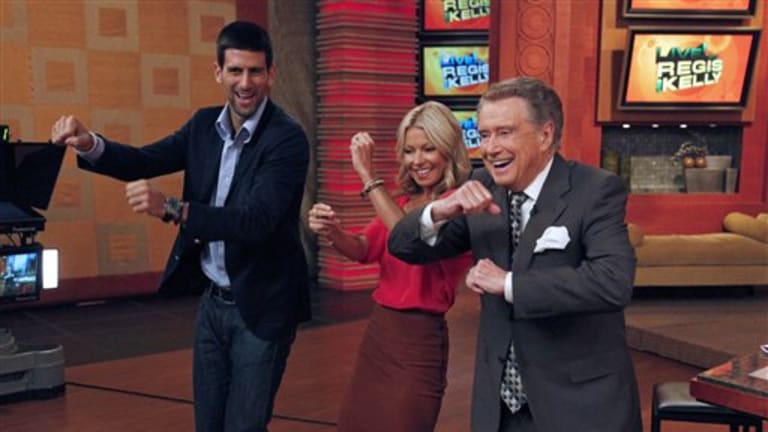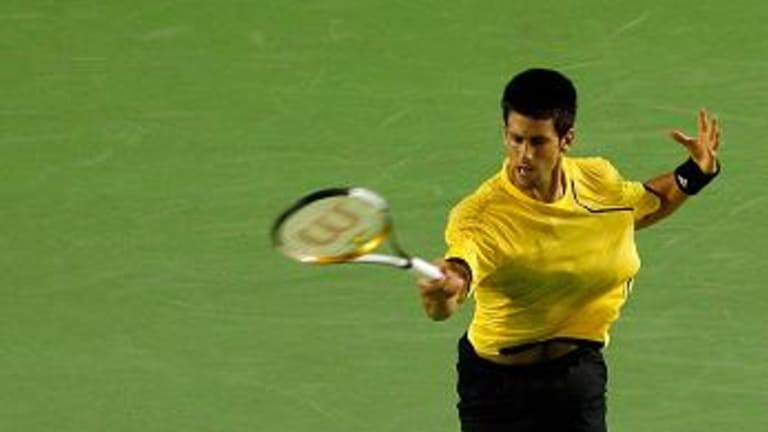Now don’t get your shorts all in a bunch. TMF is the high water mark for tennis players, and likely to become the acknowledge GOAT, sooner rather than later. I won’t insult him, given the record he’s amassed, with comparisons to a raw kid who has yet to reach a major semifinal. There are things about the Djoker, though,that I think are incomparable (like his trunk rotation, but I’m getting ahead of myself), but again – the Perfect Player isn’t necessarily destined to be the greatest player, or the most successful.
I went out to take a close look at the Djoker today, in his match against Julian Benneteau, a Frenchman who’s been playing very well here by following a simple and often deadly formula – make few errors and force your opponent to win the match by making the shots that he knows he must in order to win. Then hope he'll go all Gasquet on you, instead of demonstrate that he's got the Wilanders.
I arrived at Stadium Court 2 six games (at 3-all) in, while most of the fans were watching Andy Murray bang on Nikolay Davydenko in the big house. I took a seat right behind the north baseline, just three rows up from the wall behind the court, among a handful of big-bellied senior citizens, tanning their chicken-wing arms and backs on the green benches like a fleet of fat iguanas lounging on palm fronds. I turned off the cell phone and sat back to watch.
The first thing I jotted into my notebook, as Djokovic whacked a backhand that earned him a break of serve for 5-3, was “great trunk rotation, often punctuated by a guttural exhalation.” Trunk rotation is a big thing for me, has been every since I first aw the best practitioner, Miloslav Big Cat Mecir – a guy who did not appear to run (he was always just there, waiting for the ball) and who did not appear to swing a racquet hard enough to break an electric-eye beam.
But the ball came off Mecir’s strings with the pop of a champagne cork and unexpected pace. Djoker is just as clean, yet he takes a bigger cut at the ball and is less disposed to counterpunching than was Mecir. So he ends up hitting a heavier, more dangerous ball. But trunk rotation only rises to maximum efficiency with great timing, and that’s the Djoker’s other deep, subtle talent. The combination of timing and rotation yield maximum oomph without maximum swing speed. This is a pretty good definition of stroking efficiency.
Serving for the set, Djoker fell behind love-40, at which point he let out a visceral roar and, enraged, flung his cap to the court. This gesture appeared to end the curse, for he won the next two points with fierce, inside-out, forehand winners, each of them having every mark of a go-for-broke shot, but without the desperation. This is one cool kid. He got back to deuce with yet another big, IO forehand, but this time the ball also skipped of off the let cord.
“S*!,” Benneteau cried. Then, perhaps recalling that he’s French, he amended it to, “Merde!”
A group of shirtless college kids, with their baseball caps worn facing the wrong direction, as per current campus-correctness, wandered in and sat down to watch. Benneteau was playing well enough to force Djokovic’s hand, and each time the latter made an error – or hit a winner – he punctuated it with a war cry or a clenched fist. He’s an emotional guy, but somehow it never corrupts his stroke work, or finds expression as a poor decision, a hasty decision or a puzzling decision – which is the problem faced by guys like Gasquet.
Often, guys who play with a great deal of emotion are perfectionists; that was John McEnroe’s lifelong mantra, as well as the convenient, all-purpose excuse for his tantrums. Andy Murray and Djokovic, among others, are like that too, and their biggest enemy is the self-same perfectionism that has brought them this far. Their challenge is to keep that perfectionism from becoming a destructive force. Djokovic seems to have a handle on this, because his game doesn’t fluctuate a great deal. Those outbursts - they're just just lip service to the perfectionism he is keeping at bay.
And here’s something else. I noticed watching Gasquet that his feet are very busy, sometimes working like flippers as he hits the ball. I thought it telling that Djoker’s feet are active as well, yet it’s always a critical, split-second later than in a guy like Gasquet. That is, Djoker buys an extra, useful moment of stillness while his swing is still in progress, and that enables him to whack the kitten with a shade more power and accuracy.
Djoker broke Benneteau easily in the first game of set 2, and then crushed some gigunda serves to hold. The Djokovic serve is a thing of beauty, streamlined as a Brancusi sculpture, lethal as the strike of a cobra. It is a serve very much like that of Pete Sampras, although it probably is a shade slower. Djoker lines up with his feet nearly parallel to the baseline, his front, left foot so far ahead of his right that his calf appears to be bowed. As he begins his no-frills, leisurely toss, he shifts his weight slightly to his back foot – just enough to free up that distended left leg to respond to his deep knee bend, then act as a piston to pump his body up and forward. The motion is seamless, gathering force and speed that maxes out as he makes contact.
The racquet appears to swallow the ball before it spits it back out with explosive force, egg-shaped if Djokovic is going for the big kicker, distended like a yellow cartoon bullet if it’s a hard, flat one. Ka-boom! When Djoker blasted another one that helped him go up 2-0, it left Benneteau shaking his head, a man in sorry communion with his pending doom.
It was at this point that I jotted down that most famous line in the literature of rock music, Jon Landau’s pronouncement: I have seen rock and roll (tennis) future and it is Bruce Springsteen (Novak Djokovic).
The games began to flow quickly; Benneteau was losing blood fast and nothing he did would stem the tide. A lot of this was because of Djokovic’s ability to compete – to press the attack without relenting, or allowing his focus to dim. Perfect execution is a high wire act; let a sliver of doubt or distraction enter your consciousness and you fall off the string, although in tennis it may take a while to hit the ground. It’s an especially cruel sport that way.
On this day, though, the Djoker was not about to fall. My next note is an aside written as Djokovic starts serving the fourth game: The PA announcer comes on and booms out: “. . . and then, Czech teen-age sensation Nicole Vaidisova, giving autographs over at the Tennis Warehouse tent!”
I swear, by the time I finished my note, Djoker was up 4-0. When Benneteau held for 1-4, I had the feeling that Djokovic was taking a breather. He then ran out the next two games and the match, 6-3, 6-1.
Did Benneteau play into Djokovic’s hands? It depends on how you look at it. The way I saw it, he held up the match, showed it to Djoker, and, in effect, said: If you can take it, it’s yours. And he took it.
I wandered away thinking I had just observed the Perfect Player, so I figured, what the hail, I may as well tell the guy. So the ATP hooked me up with Djokovic. Mainly, I was interested in learning in a little more detail how a guy with very little access to top tennis training, and the resources it requires, ended up owning a game that’s cleaner than a child’s plate on spaghetti night.
I sat down with Djoker in an empty office off the player’s lounge. In case you’re interested, he has an impressive, almost old school (1950s) look, enhanced by the erect carriage of a soldier. He has no hairstyle – just short, dark hair of even length all around. It's a Spartan look. What you may not see on television is that he has very finely made features that are as perfectly balanced as his game, although his eyes are a little close together. He’s friendly and direct. I told him that I wasn’t there to kiss his butt but I thought he was as close to the Perfect Player as I had ever seen, and asked if that was a matter of nature or nurture.
First, he laughed at my disclaimer. Then he said, “I can say in one hand that it is destiny. In Serbia, we never had a Top 15 player after Bobo (Slobodan Zivoinovic reached No. 19), so it was hard for me to develop and succeed. But it was a half-and-half thing between my talent and my first coach’s work, so I was very luck to have this coach.”
That mentor was a woman, Jelena Gencic, who had also worked with Monica Seles and at one point traveled with Goran Ivanisevic (I met her briefly).Djokovic says that Gencic gave him the “basic things” and watched over him like a hawk between the ages of 6 and 11, after which the family brain trust decided to allow him to go off to the former Yugoslav star Nikki Pilic’s tennis academy in Europe (as per Gencic’s advice), where he rubbed elbows with the likes of Boris Becker and Goran Ivanisevic. “It was difficult for my family to leave a child of 12 in another country, but after the first few days the uncle who took me to Munich, and I was left for myself. But it was a thing I needed to do.”
Djokovic originally played a one-handed backhand, but he described himself as a “skinny” kid who didn’t make enough power, and thus always found himself on the defensive. So he adopted the two-hander. Everything else, more or less, just continued to develop naturally. Pilic, who had helped Ivanisevic with his serve (“You know how he’s serving,” Djokovic asked, laughing), also fine-tuned the Djokovic delivery.
The only other thing that changed as Djokovic began to make his move in the pros was his forehand. He had good run in Paris in 2005, but after he retired during his match with Guillermo Coria (after winning the first set), Gencic pulled him aside. “She said, ‘You’re playing great, but when you have a chance to finish the point with my forehand you use too much spin. Make it flatter.'" He paused. “She’s great, I’m telling you. . .”
And of his mental toughness, Djokovic said: “I matured a lot. . .I am trying to hold my emotions as much as I can, but that’s just me. I like to scream on the court. I like to fight. I like to compete.”
And what did he think about this “Perfect Player” theory?
He laughed again. “I can’t say I’m the perfect tennis player. Nobody can be perfect and I think I have a lot to improve on (serve, making best use of his opportunities, attacking the net were the ones he cited).”
So perhaps he isn’t perfect, but he’s a spectacularly gifted player who’s not going to be undone by his perfectionism, either. And that’s as perfect as anyone has a right to ask.

